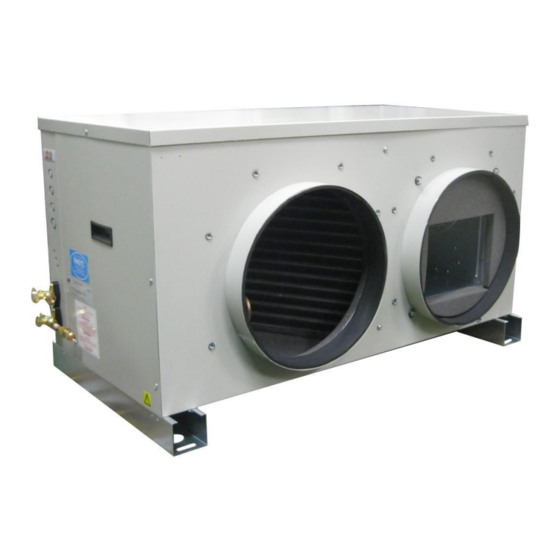
Table of Contents
Advertisement
Quick Links
1.
TEV Ltd recommend that personnel working on this equipment be skilled and fully conversant with
the appropriate Air Conditioning, Refrigeration and Electrical practices and have sound knowledge
of current Industrial Safe Working practices.
2.
These units contain live electrical components, moving parts and refrigerant under pressure.
Always site out of reach of children and protect from vandalism.
3.
The units have fan speed control, start delay timer, HP and LP switches and a contactor fitted as
standard
4.
The data plate only gives information for the outdoor unit. For system details add input power and
current of indoor and outdoor unit, including any heater load.
5.
FUSES- for recommended fuse size see indoor unit instructions.
DCU+ OUTDOOR UNITS & DHPU(L) OUTDOOR HEAT PUMP UNITS
INSTALLATION INSTRUCTION
1
54208003-13
Advertisement
Table of Contents

Summary of Contents for Marstair DCU+ Series
- Page 1 INSTALLATION INSTRUCTION TEV Ltd recommend that personnel working on this equipment be skilled and fully conversant with the appropriate Air Conditioning, Refrigeration and Electrical practices and have sound knowledge of current Industrial Safe Working practices. These units contain live electrical components, moving parts and refrigerant under pressure. Always site out of reach of children and protect from vandalism.
-
Page 2: Item Description
CONTENTS ITEM DESCRIPTION QUANTITY Stabilizing brackets No10 Screws Cable glands NOTE: Units are supplied with a polystyrene packing piece supporting the blower assembly, this MUST be removed prior to commissioning. DIMENSIONS & WEIGHTS SPIGOT AIR OUT Model Spigot Ø Weight (kg) DCU+ 15 1004 DCU+ 20... -
Page 3: Floor Mounting
MOUNTING Ducted units are designed to be hung on a wall (brackets available as a kit), suspended from a ceiling (installer supplied fittings), or to stand on a flat surface. Whichever method is used it is essential that the mounting surface is capable of supporting the unit's weight. Leave space around the unit for air circulation and access for installation and maintenance. - Page 4 CONDENSATE DRAIN DHPU(L) CONDENSATE DRAIN DHPU(L) The DHPU(L) coil will act as an evaporator during the heating cycle and create water. A condensate drain must be fitted. Remove the plate from the valve end mounting foot and fit a 22mm ID hose to the copper stub. Route the hose through one of the knockouts.
- Page 5 The maximum pipe lengths to be used for each pipe size and outdoor unit are shown in the table below. Use of these sizes and lengths is recommended in order to achieve optimum system performance. Smaller suction line sizes may be used but will impose a loss in performance of approximately 2% per 1K additional suction line pressure drop on total cooling and approximately 1% on sensible cooling.
-
Page 6: Heat Pump Heating
PIPE CONNECTIONS / RESTRICTORS Outdoor units are supplied with the following male flare connections (in inches) :- DCU+ MODEL DHPUL MODEL EXPANSION EXPANSION SUCTION SUCTION NOTE: Ensure both service valves on the outdoor unit are closed (IN, fully clockwise) before commencing installation. - Page 7 Connecting the pipework: a. Remove the flare nuts from the suction service valve and the expansion device as appropriate. b. Ensure that both the suction and expansion lines are fully insulated. c. Place the flare nuts over the incoming pipework and flare the pipe ends. d.
- Page 8 4. If a manual HP cutout is fitted, ensure that the reset button is depressed. 5. Additional refrigerant and polyolester oil should be introduced through the Schrader valve on the indoor unit, or the service port on the suction service valve on the outdoor unit. Ensure the refrigerant is the correct type, as shown on the rating plate.
- Page 9 b. Switch on the system, and run for a few minutes to stabilise. c. The head pressure should be approximately: to achieve this remove sealing plug and insert 2mm or 5/64” R407C: 275-280 psig (18.9-19.6barg) allen key into setting screw. Turn allen key clockwise (+) or counter clockwise (-) to readjust the setting. Do not turn setting screw more than 3 turns clockwise (+3).
-
Page 10: Outdoor Unit Wiring
ELECTRICAL Mains, control and interconnecting cables must be supplied and fitted by the installer. Cables must be size compatible with the recommended fuse for a given system. An isolator switch should be positioned within easy reach of the indoor unit. The equipment must be earthed. - Page 11 DHPUL: 1Ø DHPUL 3Ø DHPUL Fused supply (400V 3Ø 50Hz) Fused supply (230V 1Ø 50Hz) disjoncteur a fournir (400/3/N/50) disjoncteur a fournir (230/1/50) abgesicherts versorgung abgesicherts versorgung (230V 1Ø 50Hz) (400V 3Ø 50Hz) INDOOR INDOOR POWER - TO SUIT SUPPLY FUSE PUISSANCE - FOURNIR UNE ALIMENTATION PROTÉGÉE HAUPTLEITUNG PASSEND ZUR ABSICHERUNG Signal / Ansteurung...
- Page 12 FUSES The system and its supply/interconnecting wiring must be protected by fuses, preferably High Rupture Current (HRC) motor rated types (to EN 60269) or miniature circuit breakers (to EN 60898) or local codes having similar time lag characteristics, that allow starting of the compressor yet still afford close overcurrent protection under running conditions.



Need help?
Do you have a question about the DCU+ Series and is the answer not in the manual?
Questions and answers